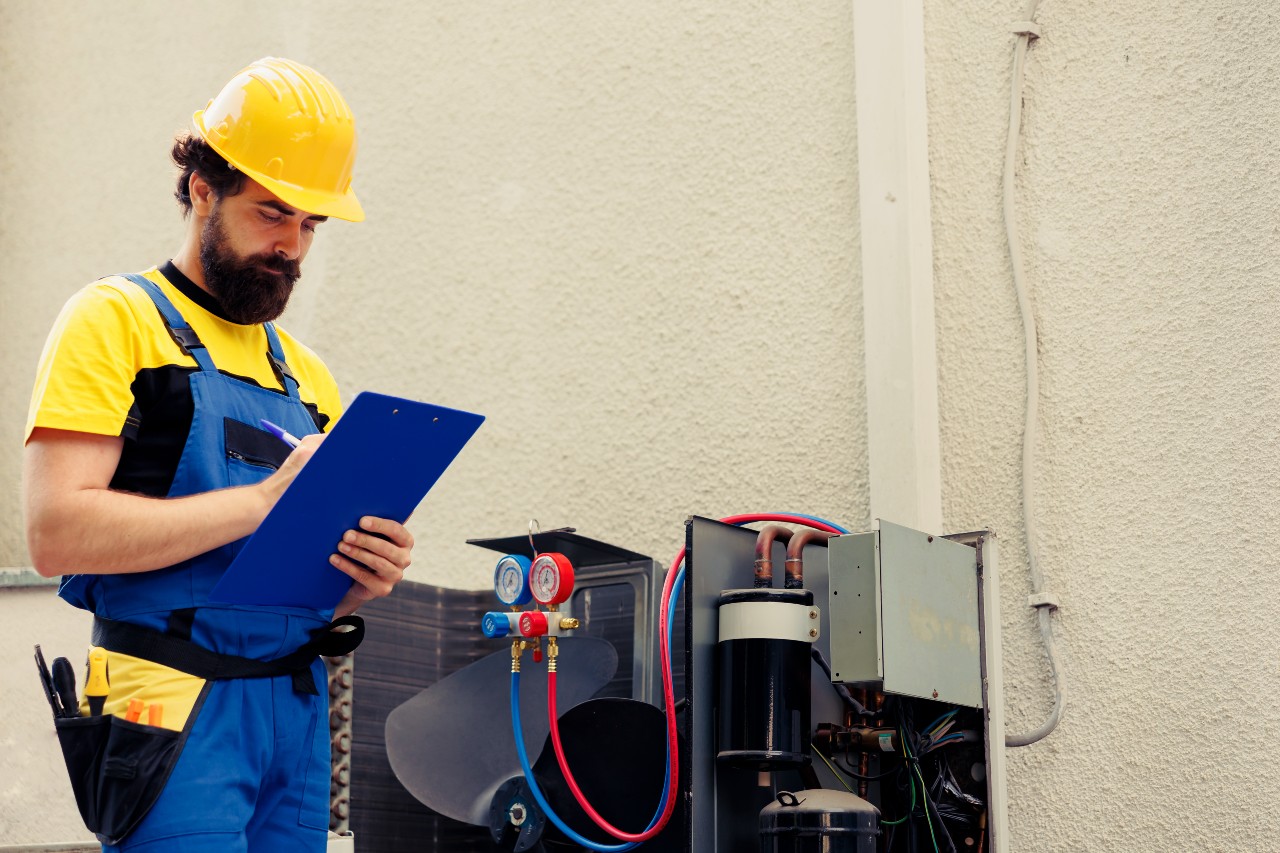Keeping your HVAC system in good shape is important for running a safe and efficient facility, whether it’s a factory, office, or school. A failing HVAC unit can make any space uncomfortable, so it’s essential to stick to a maintenance schedule. However, not all equipment needs the same type of care, and maintenance tasks don’t always follow the same schedule. To stay organized and ensure you don’t miss any maintenance tasks, it’s a good idea to use an HVAC maintenance checklist for your commercial system.
What is Commercial HVAC Maintenance?
Commercial HVAC maintenance refers to regular checkups and servicing of the heating, ventilation, and air conditioning (HVAC) system in a business setting. Unlike your home’s HVAC system, commercial systems are much larger and more complex. They play a critical role in keeping employees and customers comfortable, which can directly affect productivity and customer satisfaction.
The specific maintenance tasks will vary depending on the type of HVAC system you have and the size of your building. However, it’s generally recommended to have your commercial HVAC system serviced at least twice a year, once before the cooling season and again before the heating season.
Importance of HVAC Preventive Maintenance
Switching to a preventive maintenance plan for HVAC systems has several benefits:
Extended System Lifespan
HVAC manufacturers test their products extensively to determine the optimal maintenance schedule. Following the manufacturer’s guidelines ensures that your system lasts as long as possible, giving you the best return on your investment.
Lower Energy Bills
In most homes and buildings, the HVAC system uses more energy than any other equipment. Regular maintenance like cleaning coils, checking refrigerant levels, and lubricating motors keeps your HVAC system running efficiently. An inefficient HVAC system needs more energy to heat or cool your space, leading to higher energy bills.
Fewer Repair Bills
While all HVAC systems will need repairs eventually, regular preventive maintenance helps catch potential problems early. This allows your technician to fix issues before they become costly and complicated.
Improved Safety and Air Quality
Regular preventive HVAC maintenance tasks, such as cleaning or replacing filters, lubricating parts, checking electrical systems, and cleaning coils, are essential for spotting potential fire hazards and air quality issues. Neglecting these tasks can cause HVAC systems to become damaged or clogged, leading to higher humidity levels, dust, and debris in the air. Prolonged exposure to poor indoor air quality can seriously affect the health of a building’s occupants.
What Does HVAC Maintenance Include?
The HVAC maintenance process should cover three main components to ensure proper upkeep of your system:
- Cleaning: Regularly clean filters, coils, and other parts to prevent buildup of dust and debris.
- Testing and Inspecting: Routinely test and inspect the system’s electrical components and overall functionality to catch potential issues early.
- Replacing: Replace worn-out or damaged parts, such as filters and belts, to maintain optimal performance and safety.
Commercial HVAC Maintenance Checklist
Here’s a simple checklist for facility managers to keep their HVAC systems in good shape:
- Change Filters Regularly: Swap or clean filters every 1-3 months to keep the air flowing well and the air quality high.
- Get Yearly Inspections: Schedule a yearly checkup with a certified HVAC technician to catch and fix any problems.
- Clean Air Ducts: Keep air ducts clear of dust and junk to maintain good airflow.
- Check Thermostat: Make sure your thermostat is set right for the season and is working correctly.
- Keep Outdoor Units Clean: Clear away any debris around outdoor units to help them run smoothly.
- Keep an Eye on Refrigerant: Have a professional check the refrigerant levels and top them up if needed to keep everything running efficiently.
- Check and Seal Ducts: Look for any leaks or blockages in your ducts and seal them up to save energy.
- Keep Moving Parts Lubricated: Keep motors and bearings oiled up to stop them from wearing out.
- Check Electrical Connections: Make sure all the wires are connected properly to avoid any safety issues.
- Test System Controls: Try out the start-up, operation, and shutdown to make sure everything’s working as it should.
Strategy 1: Keeping Up With Inspections and Everyday Maintenance
Having your HVAC system checked regularly by professionals is key to keeping it working well. These inspections, done by trained experts, help catch any problems early, saving you time and money down the line. It’s also important to give the outdoor unit regular maintenance, like cleaning and checking for damage. This keeps your system running efficiently and lasting longer. Regular cleaning prevents dirt buildup, which can make your system less efficient and use more energy. Overall, routine maintenance and inspections are essential for keeping your HVAC system running smoothly.
Strategy 2: Changing Filters As Per Schedule
Replacing your HVAC system’s filters regularly is an important strategy in keeping your air clean and your system running efficiently. Over time, these filters trap dust and particles, which can clog them and make them less effective. When filters get clogged, your system has to work harder to move air throughout your workspace, which can lead to higher energy bills. Additionally, dirty filters aren’t as good at capturing contaminants, which can contribute to poorer indoor air quality. Making a habit of changing your filters regularly helps keep your air clean, your system running smoothly, and can potentially prevent costly repairs down the road, extending the lifespan of your HVAC system.
Strategy 3: Ductwork Maintenance
Taking care of your HVAC system’s ductwork is important for efficient airflow and saving energy. Ducts distribute air throughout your building. If they’re not sealed or insulated properly, air can leak out, making your system work harder and increasing your energy bills. By sealing leaks and ensuring good insulation, you can improve your system’s efficiency. This means your workspace heats up or cools down faster, uses less energy, and saves you money. Regular ductwork maintenance is a simple way to keep your HVAC system running smoothly.
Strategy 4: Thermostat Management
Getting your thermostat settings just right is essential for keeping your building comfortable and saving energy. Thermostats control your heating, ventilation, and air conditioning (HVAC) system. If they’re set too high or too low, your HVAC system might work harder than needed, leading to higher energy bills. Upgrading to a smart thermostat can help even more. These devices let you adjust settings from your phone and learn your routine to save energy. With a smart thermostat, your HVAC system only runs when necessary, potentially saving you money and keeping your workplace cozy, even when you’re away.
Strategy 5: Switching to Preventive Maintenance
Preventive maintenance is all about looking after your heating, ventilation, and air conditioning (HVAC) system before problems pop up. It means regularly inspecting and catching issues early. Just like getting your car’s oil changed regularly to avoid engine troubles, preventive maintenance for HVAC systems involves cleaning parts, checking for leaks, and making sure everything is running smoothly. This care not only makes your system work more efficiently, saving you money on energy bills but also helps it last longer. By keeping up with maintenance, you reduce the chances of sudden breakdowns, which means fewer surprise repairs and expenses. Essentially, preventive maintenance ensures your HVAC system stays in top condition, ensuring it functions effectively for years to come.
Streamline Commercial HVAC Maintenance With NEXGEN
Efficient maintenance is essential, whether you’re managing one HVAC system or several. NEXGEN makes preventive maintenance management straightforward with its dedicated preventive maintenance features.
Using NEXGEN’s robust CMMS empowers your team to:
- Effortlessly schedule equipment maintenance.
- Set up alerts for timely parts procurement.
- Transparently track costs.
- Automate recurring work orders on a specified schedule.
- Establish automated preventive maintenance tasks based on equipment usage metrics.
- Instantly generate work orders and notify technicians via mobile alerts.
- Seamlessly attach equipment manuals and instructions to work orders.
Ready to streamline your maintenance process?






